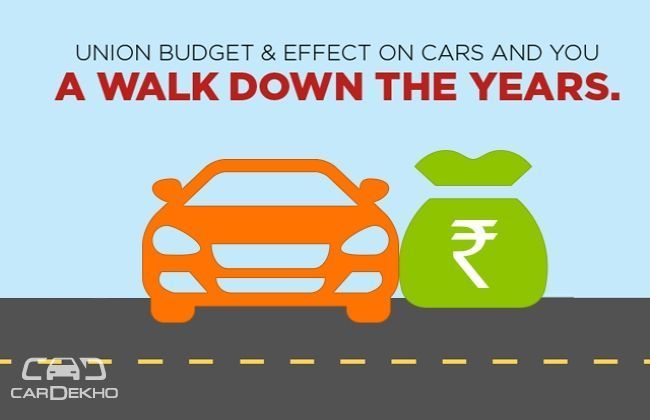Union Budget & Effect on cars and you - A walk down the years
Modified On Feb 20, 2015 07:00 PM By Raunak
- 2.3K Views
- Write a comment
We have moved through an appalling 2013 which saw the decade's worst slump in the auto industry. Auto experts are blaming the rising petrol price which is partially true, but then we all know that fuel costs will always rise. This has also made diesel India's favorite fuel choice. Now the government is changing the mindset by equalizing the gap between diesel and petrol prices. Moreover, the galloping interest rates and dwindling economy further fueled last years auto crisis ultimately resulting is car sales to drop to 9.6 percent in 2013, an all time low.

Let us give you a flashback to show how excise duty and government policies in various budgets took criss-cross turns in shaping the present Indian auto industry.
Nearly a decade ago in the 2004-2005 Union Budget the excise duty on passenger cars was 24 percent. The main reason behind the booming auto sector for these years is the declining excise duty. Things changed during the 2006-2007 Union Budget as it marked a new beginning in the Indian auto sector.
2006 - Turning Point for Small Cars: Hatchbacks are India's favorite choice. This is clearly reflected in the majority share hatchbacks hold in the market, which is close to 50 percent. If we look-back at the past budget regimes 2006 was the turning point in the history of automobiles when the government separated the excise duty cut for small cars.
According to the government cars under 4 meters having petrol engines below 1200cc and diesel engines under 1500cc will enjoy a special reduced excise duty making them cheaper compared to others. The result? The market is now flooded with sub-4m entry level sedans with plenty of more expected to foray in coming months.

2007-2008 - Focus on Research & Development: In the Union Budget 2007-2008 after separating the excise duty cut the government focused on in-house R&D. This budget saw a deduction of 150 percent for the expenditures related to in-house research and development. The 2008-09 budget saw further reduction in the excise duty for small cars to 12 percent from earlier 16 percent. In December, later that year blessings came as the excise duty was further reduced to 8 percent!
2009 - Large Cars Got Cheaper: Furthermore in the Union Budget 2009-2010 excise duty on small cars remained the same, while on large cars it was reduced to 20 percent (plus 15,000) from 25 percent (plus 20,000). The 2010-2011 budget further focused on in-house R&D with 200 percent deduction in expenditures. Till the time the budget 2011-2012 was announced excise duty crawled-down to 10 percent. Things went on the down slope.
2012-2013 Increase in Excise Duty: In the union budget of 2012-2013, excise duty on small cars went uphill to 12 percent while the excise duty on larger cars grew from 22 percent to 24 percent.
The LPG (Liberalization, Privatization and Globalization) policy of the government in early 90's flooded the Indian auto space with global auto giants. By mid 90s we had Mercedes- Benz India (1994), Daewoo (1993), Ford (1995), General Motors (Opel India, 1995), Hyundai Motors (1996), Honda (1995), etc.

The 90’s policies opened flood gates to the global auto giants, while in mid 20's government focused on the in-house R&D (Research and Development). Courtesy this, in recent years we have seen plenty of in-house developed vehicles from several global players - Hyundai i10, Swift Dzire, Toyota Etios, Ford Figo, etc.
As they say 'hope rises from the ashes' the new finance minister Arun Jaitley has extended the excise duty cut which was introduced in February. The excise duty cut is extended till December 31, 2014. This pre-budget move from the government is an indicator of a positive budget which is due on the 10th of July. Moreover, the government cannot neglect a sector which contributes one-fourth of the entire GDP (manufacturing) also 18 percent of the gross excise revenue. Besides, people are hoping for improvement in road infrastructure conditions across the nation.

Apart from the expected government policies, automakers in India are also giving their 200 percent to reclaim lost ground. The year started with a glamorous and glitzy Auto Expo revealing the future line-ups of the automakers. Till now we have seen plenty of launches while several others are still awaited. Furthermore the global automakers are spreading their dealer networks in tier II, III and IV cities to tackle home-grown manufacturers as better reach means better sales. Let’s see what the upcoming budget holds for one of the largest automobile market in the world.

0 out of 0 found this helpful









